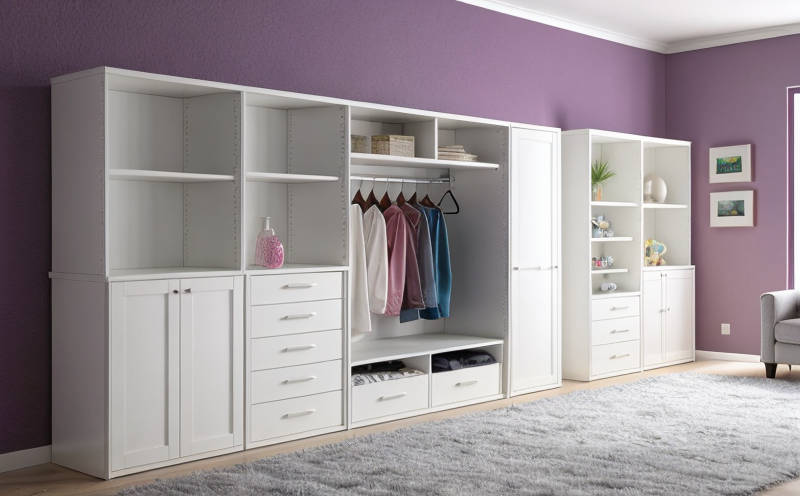ISO 4211-6 Storage Furniture Fatigue Strength Testing of Hinges and Doors
The ISO 4211 series provides guidelines on the testing methods for storage furniture. Specifically, ISO 4211-6 focuses on fatigue strength testing of hinges and doors in storage furniture, which is essential for ensuring durability and safety under repeated loading conditions.
Furniture subjected to continuous use in residential or commercial settings often experiences cyclic stress due to daily opening and closing actions. This fatigue can lead to premature failure of the hinge mechanism, compromising the structural integrity and usability of the storage furniture. Accurate and reliable testing methods are necessary for manufacturers to identify potential weaknesses before products reach end users.
The primary aim of this service is to evaluate the fatigue strength of hinges used in storage furniture according to ISO 4211-6. This involves subjecting the hinge specimens to a predefined number of cycles under controlled conditions, monitoring their behavior throughout the process, and determining whether they meet specified performance criteria.
Our testing facility adheres strictly to international standards like ISO 4211-6, ensuring that all results are consistent with industry best practices. By using advanced equipment calibrated specifically for this type of test, we can provide accurate data on how each hinge performs under simulated real-world conditions. This information is invaluable not only during development stages but also when troubleshooting issues encountered in production or after-market use.
For manufacturers looking to improve their products' longevity and reliability, fatigue testing offers significant advantages beyond mere compliance with regulatory requirements. It allows companies to identify design flaws early on, optimize manufacturing processes, enhance product performance, and ultimately build customer confidence through superior quality assurance measures.
In summary, ISO 4211-6 storage furniture fatigue strength testing of hinges and doors plays a crucial role in maintaining high standards within the furniture industry by promoting durability and safety while reducing costs associated with premature failures. Our laboratory offers comprehensive services tailored to meet these needs effectively and efficiently.
Applied Standards
| Standard | Description |
|---|---|
| ISO 4211-6 | Test methods for storage furniture - Part 6: Fatigue strength testing of hinges and doors |
| ASTM D7038 | Standard test method for fatigue properties by oscillatory loading of metal fasteners and hardware |
Scope and Methodology
| Scope | Description |
|---|---|
| Fatigue strength testing of hinges and doors in storage furniture | This includes assessing the ability of hinges to withstand repeated loading cycles without failure. |
| Specimen preparation | The hinges are typically cut from larger hinge assemblies or manufactured specifically for testing purposes. |
The methodology involves placing the specimens on a fatigue testing machine capable of applying controlled oscillatory loads. The test parameters include frequency, amplitude, and duration of loading cycles. Specimens are monitored continuously throughout the process using strain gauges attached to key points along the hinge structure.
Once the specified number of cycles has been completed (typically around 10 million), the specimens are inspected visually for any signs of damage or deformation. Any specimen that fails before reaching this count is deemed unsatisfactory according to ISO 4211-6 requirements.
The resulting data provides valuable insights into the fatigue performance of hinges, helping manufacturers make informed decisions about material selection and design modifications aimed at increasing product lifespan and reliability.
Benefits
Implementing ISO 4211-6 storage furniture fatigue strength testing offers numerous benefits to both manufacturers and end users. For the former, it serves as an essential tool for quality control during production processes, allowing companies to catch defects early in development stages or identify areas requiring improvement.
From a regulatory standpoint, compliance with these standards ensures that products meet international safety and durability requirements set forth by governing bodies worldwide. This can help avoid costly recalls later down the line if issues were not addressed earlier.
For end users, purchasing furniture tested according to ISO 4211-6 means investing in durable pieces designed to last longer with minimal maintenance needs. The peace of mind that comes from knowing one's belongings are built to withstand heavy use makes this service particularly appealing for those seeking long-term value.
Beyond mere compliance, adopting such practices demonstrates a commitment to excellence and innovation within the industry. It sets your brand apart as a leader in sustainability and quality assurance, fostering trust among consumers who appreciate responsible business practices.





